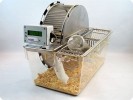Authors
F Mottarlini, G Targa, G Bottan et al
Lab
Department of Pharmacological and Biomolecular Sciences, Universita degli Studi di Milano, Milan, Italy
Journal
Journal of Neurochemistry
Abstract
Patients suffering from anorexia nervosa (AN) display altered neural activity, morphological, and functional connectivity in the fronto-striatal circuit. In addition, hypoglutamatergic transmission and aberrant excitability of the medial prefrontal cortex (mPFC) observed in AN patients might underpin cognitive deficits that fuel the vicious cycle of dieting behavior. To provide a molecular mechanism, we employed the activity-based anorexia (ABA) rat model, which combines the two hallmarks of AN (i.e., caloric restriction and intense physical exercise), to evaluate structural remodeling together with alterations in the glutamatergic signaling in the mPFC and their impact on temporal memory, as measured by the temporal order object recognition (TOOR) test. Our data indicate that the combination of caloric restriction and intense physical exercise altered the homeostasis of the glutamate synapse and reduced spine density in the mPFC. These events, paralleled by an impairment in recency discrimination in the TOOR test, are associated with the ABA endophenotype. Of note, after a 7-day recovery period, body weight was recovered and the mPFC structure normalized but ABA rats still exhibited reduced post-synaptic stability of AMPA and NMDA glutamate receptors associated with cognitive dysfunction. Taken together, these data suggest that the combination of reduced food intake and hyperactivity affects the homeostasis of the excitatory synapse in the mPFC contributing to maintain the aberrant behaviors observed in AN patients. Our findings, by identifying novel potential targets of AN, may contribute to more effectively direct the therapeutic interventions to ameliorate, at least, the cognitive effects of this psychopathology.
BIOSEB Instruments Used:
Spontaneous activity wheels (BIO-ACTIVW-M)

 Douleur - Allodynie/Hyperalgésie Thermique
Douleur - Allodynie/Hyperalgésie Thermique Douleur - Spontanée - Déficit de Posture
Douleur - Spontanée - Déficit de Posture Douleur - Allodynie/Hyperalgésie Mécanique
Douleur - Allodynie/Hyperalgésie Mécanique Apprentissage/Mémoire - Attention - Addiction
Apprentissage/Mémoire - Attention - Addiction Physiologie & Recherche Respiratoire
Physiologie & Recherche Respiratoire
 Douleur
Douleur Système Nerveux Central (SNC)
Système Nerveux Central (SNC)  Neurodégénérescence
Neurodégénérescence Système sensoriel
Système sensoriel Système moteur
Système moteur Troubles de l'humeur
Troubles de l'humeur Autres pathologies
Autres pathologies Système musculaire
Système musculaire Articulations
Articulations Métabolisme
Métabolisme Thématiques transversales
Thématiques transversales SFN2024: Venez rencontrer notre équipe sur le stand 876 à Chicago
SFN2024: Venez rencontrer notre équipe sur le stand 876 à Chicago 